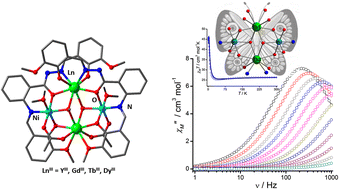Exchange-driven slow relaxation of magnetization in Ni II2Ln III2 (LnIII = Y, Gd, Tb and Dy) butterfly complexes: experimental and theoretical studies†
Abstract
The tetranuclear NiII2LnIII2 complexes, [{L′2{Ni(MeOH)(μ-OAc)}2(μ3-MeO)2Ln2}, LnIII = YIII (1), GdIII (2), TbIII (3), and DyIII (4)], were prepared using a Schiff base ligand, H3L [H3L = 3-{(2-hydroxy-3-methoxybenzylidene)amino}-2-(2-hydroxy-3-methoxyphenyl)-2,3-dihydroquinazolin-4(1H)-one, where {L′}3− is the deprotonated open structure of H3L]. X-ray crystallographic analysis of 1–4 revealed that all the complexes crystallized in the orthorhombic (Pbcn) space group, and possessed an isostructural tetranuclear butterfly or defect dicubane like core. Direct current magnetic susceptibility measurements performed on 2–4 revealed that all these complexes show an intramolecular ferromagnetic exchange coupling. Well resolved zero-field out-of-phase signals in ac magnetic susceptibility measurements were observed only in the case of 3 (Ueff = 13.4 K; τ0 = 4.1(7) × 10−7 s). This was attributed to the comparatively strong NiII–TbIII magnetic exchange coupling. DFT and ab initio calculations were carried out on 1–4 to ascertain the nature of the ferromagnetic NiII–LnIII (JNi–Ln) and LnIII–LnIII (JLn–Ln) interactions. Magnetic anisotropy and magnetic relaxation mechanisms were discussed in detail for 3 and 4. Theoretical studies provide a rationale for the slow relaxation of magnetization in 3.



 Please wait while we load your content...
Please wait while we load your content...